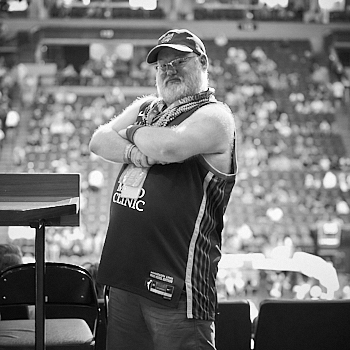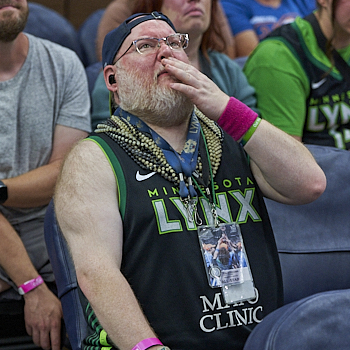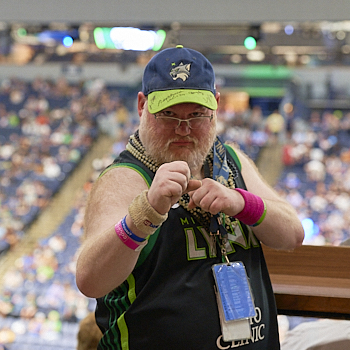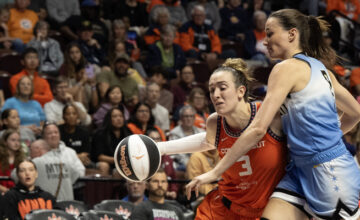 Every sports team has fans. They attend games, watch from home on television or in a sports bar, and follow the players and teams through newspapers, websites and social media. The fan is the backbone of the business we know as sports entertainment.
Every sports team has fans. They attend games, watch from home on television or in a sports bar, and follow the players and teams through newspapers, websites and social media. The fan is the backbone of the business we know as sports entertainment.
Then there are those who are Superfans. These are the ones who dress up in costumes, wear face paint, have fun with goofy antics and are looked at by some fans as the life of the party, and are jeered by others for being obnoxious or over-the-top.
If done correctly, Superfans can be good for business. They are some of the most passionate people at games, and that passion can often be infectious. Of course that passion can also turn into television appearances coming out of timeouts or at halftime, which can be good for branding, for both the team and the person.
There are some Superfans who have been around for so long that they are never forgotten. John “The Drummer” Adams was one. When he passed away in January at age 71, the Cleveland Guardians (formerly Indians) major league baseball team honored his legacy with a moment of silence, and had the official team mascot bang the drum from Adams’s seat, a tradition that Adams had started in 1973 when he attended the first of what would become more than 3,500 home baseball games, missing only 45 games in a 48-year span.
We can’t forget about Rollen Stewart. He began holding up “John 3:16” placards starting with the 1977 NBA Finals and was seen at many key sporting events with his familiar sign until 1992 when he was arrested on kidnapping charges. (He’s still in prison.)
Stewart may be an anomaly here, since he was trying to use sports to evangelize, but getting a glimpse on television propels many of the Superfans into passionate fandom. Perhaps we can thank Rollen Stewart for that after all.
Zema Williams, an Army veteran who was selling cars in Washington, D.C., decided to dress in a headdress and bring a tomahawk prop to the Washington Redskins – Dallas Cowboys game at R.F.K. Stadium on Oct. 2, 1978. He received so much attention after the television cameras saw him that he built up the persona of “Chief Zee” and continued the tradition until he passed away a week before the start of the 2016 training camp. Even though Chief Zee was highly controversial during the effort to get the team name changed, he was still beloved by most fans and the organization. (The Redskins have since changed their name to the Commanders.)
There are other less offensive Superfans. The Philadelphia Eagles have “Birdman,” complete with winged helmet, cape, mask and beak with stuffed eagles on his shoulder. Portrayed by Joe Ripley, a Union carpenter from Philadelphia, he’s been portraying Birdman since 1986.
The Green Bay Packers have “The Owner.” Steve Tate, who grew up near Madison, Wis., wears a No. 15 Bart Starr jersey to games both home and away. In November 1997, he was able to purchase a share of Green Bay Packers stock. When the Packers made the playoffs two months later, his mother was able to purchase four tickets to the first playoff game. In order to mark the occasion of his ownership status, he put the words “NFL Owner” on the top of a foam rubber cheese head. He’s been known as “The Owner” ever since, and is good friends with Wayne “Ultimate Packer Fan” Sargent, another Packers Superfan.
Even the WNBA has had Superfans. In 2009, Alex Chambers traveled to every WNBA arena that season (there were 13 teams then), blogged about it, and wrote the book “13 Teams, 1 Journey.” He even got Bridget Pettis, then an assistant coach for the Phoenix Mercury, to write the Foreward. Chambers may not have worn outrageous regalia or donned face paint, but it takes a special level of dedication to travel to every single arena in the league in one season.
And though he isn’t as well known as the other Superfans just mentioned, if you watch the commercial breaks for Minnesota Lynx games, you might get a glimpse at “Beadman,” a stocky bearded guy wearing a Lynx jersey with wristbands on and numerous beads adorning his neck. Television crews from the local Bally Sports North feed love to feature him as well as crews from ESPN for nationally televised games.

Minnesota Lynx Superfan Colin Titcomb watches the Sept. 3 Minnesota Lynx – Phoenix Mercury game with suspense from his near courtside seat at Target Center. Photo by Abe Booker III/Sportspage Magazine
His name is Colin Titcomb, a 47-year old convenience store manager living in a suburb of Minneapolis. He has been frequenting Target Center for Minnesota Lynx games since they played the Houston Comets on July 25, 1999, their inaugural year. Though he bought single game tickets in the first year, he bought his first season ticket package after the season concluded and has been a season ticket holder ever since.
“I went to the game, had a blast and decided to go to another. After the second game, I was hooked. I went to the rest of the games in 1999. Twenty-four seasons later, here we are,” said Titcomb.
While growing up, his mother was a tennis coach and his sister was a tennis player.
“I’ve always been a fan of women’s sports, having grown up in a very women’s-sports friendly family. As I grew older, I went to a few [University of Minnesota] Gopher women’s basketball games here and there, even when they weren’t very good. It was still fun,” he said.
Though he was just a fan when he started, the Superfan persona was an accident.
“I was fairly early in my career [at the convenience store] and we would do charity fundraisers. They encouraged us to dress up and be kind of crazy [for the promotions]. My boss bought some beads for us to wear with our costumes,” Titcomb explained. “One day I had to go from work right to the game, and I had forgotten to take off the beads. It was a hit. Then I continued collecting more beads to use in charity drives and just started wearing them to games.”
He wears a wristband on his right arm that was part of an in-stadium giveaway a few years ago, and has worn wristbands given to him by former Indiana Fever guard Tully Bevilaqua and now Las Vegas Aces head coach Becky Hammon, following Hammon’s final regular season game at Target Center when she retired from playing for the San Antonio Stars.
Titcomb sits behind the basket on the baseline near the visitor’s bench, where he has had seats since 2004.
“I’ve always sat in that section, but I was in Row 13 and stayed there for a few years. Because I’m a creature of habit, I kept moving down as both my fandom and budget increased,” he admitted.
In 2010, in what became of of the many memorable moments for him, Lynx forward Charde Houston invited certain fans onto the Target Center floor to take part in the team’s post-win dance.
“That morphed into the kids going onto the court,” he explained. “I’m rather sad that they got away from that as it was enjoyable, even if it was kids only.”
Because the busy season at his job is during the summer months, he does not get a chance to travel to road games, like other Superfans do. He also sports his regalia in the winter months for his second sports-love, women’s hockey, and does travel with other Gopher women’s hockey fans as those are “much more drivable destinations.”
He recalls an incident when a Lynx hat wearing customer visited his store.
“Oh, Lynx fan. Cool. So am I,” Titcomb said. When he looked at the name on the credit card to process the transaction, he saw that the customer was none other than the Lynx then head coach. “Coach Zierden, I’m Colin. Nice to meet you.”
There are certain responsibilities that come with being a Superfan, Considering that the Lynx have kept community involvement and charitable giving at the forefront of their identity, one of those responsibilities for Titcomb is supporting the team’s charitable efforts in the community.
There is the case in 2009 when the team held a fundraiser at the Target Center titled, “Lynx Go Pink.” The players, coaches, front office members and staffers freely mingled with the guests, who each paid $25 admission, and manned various game stations. Some of the stations were for carnival stations, but others were for the Nintendo Wii gaming system.
Being a video gamer himself, Titcomb went over to a Wii station and ended up bowling against then-head coach Jennifer Gillom, who had taken over as head coach from Zierden a few days before the regular season began.
“I introduced myself, and told her that I had enjoyed seeing her play with Phoenix when they visited in the Lynx’s early days,” said Titcomb, who admitted that the coach defeated him by a few pins. “It was amazingly fun. We exchanged hellos and small talk for the remainder of the season, and I joked about wanting a rematch a few times.”
It was Gillom’s only season at the helm of the Lynx. After the Detroit Shock team was sold and relocated to Tulsa, the Lynx hired former Shock assistant coach Cheryl Reeve as the new head coach, a position Reeve still holds today.

Minnesota Lynx Superfan Colin Titcomb shows off his wristband collection and autographed hat prior to the Sept. 3, 2023 game against the Phoenix Mercury at Target Center. Photo by Abe Booker III/Sportspage Magazine
Being a sports fan in Minnesota can try one’s patience. There are not that many championships that are won by Minnesota sports teams. Outside of the Lynx and the Minnesota Twins minor-league affiliate, St. Paul Saints, the last time a major professional sports team from Minnesota won a championship was 1991 when the Twins beat the Atlanta Braves in the World Series.
“Winning that first [Lynx] championship in 2011 was unbelievable. It was nice to finally support a pro champion since the Twins in 1991,” he said.
His biggest moment on camera came during the decisive Game 5 of the 2017 WNBA Finals against the Los Angeles Sparks.
“They caught me in a still shot during the game and a co-worker of mine took a picture of his television screen and sent it to me. He was a senior in high school at the time and he sent it around to a bunch of his buddies,” he explained. “For weeks I had high school students coming up to me to let me know they saw me on ESPN.”
Yet for Titcomb, all of the adulation that he gets from being on the in-stadium jumbotron or on television for his costuming and fandom is fine, but he prefers to keep the focus on the team.
He’s had his photo taken holding a championship trophy with then-chief operating officer Roger Griffith. He’s talked to head coach Cheryl Reeve. Like most fans, he enjoys when players fist bump him. But he’s an introvert at heart who has had to adapt at being an extrovert when he dons his regalia.
He wears the jersey, beads and wristbands. He sits behind the basket near the visitor’s bench. When there is something to cheer about, he stands up and yells passionately. He fist bumps people sitting next to him. During free throw attempts, he’ll wave his hands in the air. When the PA announcer asks “Whose House?” He’ll yell out the proper response of “Our House” with the rest of the fans. Occasionally, he’ll even take part in a team promotion on-court during a timeout.
But there are rules to fandom, he insists. There are rules.
“Go to all the games. Be loud, but be respectful of those around you,” he cautions. “Keep it clean. Don’t swear in front of the kids. Don’t do anything foolish to get yourself tossed. Otherwise, go crazy and have fun if you want to.”
Twenty-five regular seasons have now passed since Titcomb went to his first Lynx game. Now the team is the sixth seed in the playoffs and is set to take on the Connecticut Sun in the first round series. If the Lynx push the series to a third game, it will be played on Sept. 20 at Target Center, and we can expect the Superfan to be perched in his seat on the baseline near the visitor’s bench. If the team makes it through to successive rounds, Titcomb will be right there with other Lynx regulars, cheering on their beloved team.
When asked where he thought he would be in five years, Titcomb smiled.
“Sitting right there cheering my butt off,” he said.
Such is the life of a Superfan.



